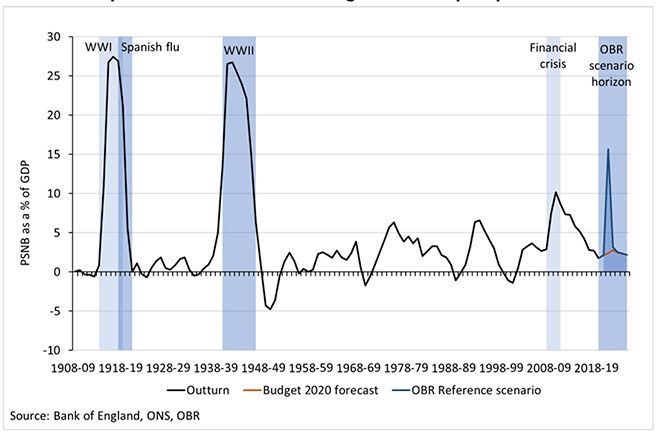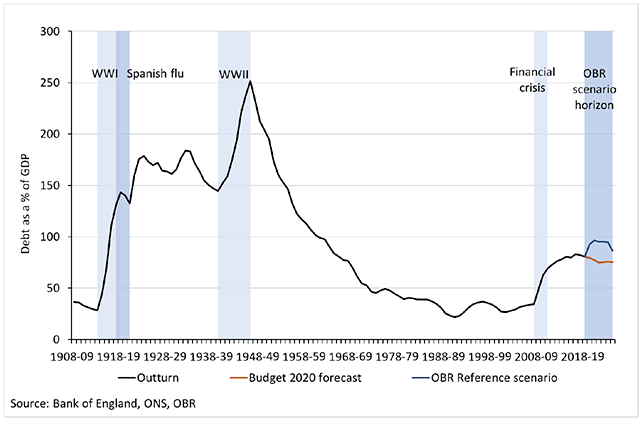Coronavirus (COVID-19): UK fiscal path – a new approach
This paper sets out ten principles the Scottish Government believes the UK Government should follow to support the UK economy and public finances as we begin to recover from the impacts of coronavirus.
UK public finances and the expected scale of borrowing and debt
Fiscal Outlook
The COVID-19 pandemic, and the resulting reduction in economic activity, will significantly raise government expenditure and reduce tax receipts, with negative implications for borrowing and public sector net debt. In its illustrative scenario for a three-month lockdown, the OBR suggests that borrowing could increase to £308 billion in 2020-21, a £253 billion increase compared to its March 2020 forecast. This would take the fiscal deficit to 15.7% of GDP, its highest level since the Second World War and well above the level seen at the height of the 2008-09 financial crisis (see Chart 3).[3]

Chart 3 Description
A chart showing the evolution of the UK public sector net borrowing, as a share of GDP, from 1908 to 2024. Borrowing was highest during the World Wars, peaking at over 25% of GDP from 1915 until 1918, and from 1940 until 1943. According to the OBR’s reference scenario, borrowing is estimated to reach almost 16% of GDP in 2020, higher than the 10% peak reached during the 2008 Financial Crisis.
This economic shock comes at a time when the UK's public finances have not yet fully recovered from the financial interventions to support the banking sector in 2008-09. Public sector net debt is expected to rise by almost 20 percentage points to around 96% of GDP in 2020-21, its highest level since the 1960s. As the rise in the deficit is currently expected to be temporary, debt is expected to remain at a stable, though elevated, level beyond 2020-21. This differs from the debt trajectory following the financial crisis when debt continued to rise as a share of GDP, until 2016-17.

Chart 4 Description
A chart showing the evolution of the UK public sector net debt from 1908 to 2024. Debt increased sharply during the World Wars, peaking at over 250% of GDP in 1946. Over the course of four decades, debt fell to 35% of GDP, and stabilised around this level until 2007. During and after the Financial Crisis, debt rose again to 80% of GDP and it is now estimated to reach almost 100% of GDP under the OBR’s reference scenario.
Despite this increase in debt, historically low interest rates, supported by an expansionary monetary policy, mean that UK public sector debt remains affordable by historical standards. Indeed, the OBR forecast that debt interest payments will now be lower than before the crisis began, even with the additional borrowing. There are also no signs that the UK Government is struggling to finance itself. Gilt auctions are consistently and significantly oversubscribed and on some issuances yields have turned negative.
However, the fiscal outlook also depends on how quickly the economy recovers and whether there are any long-term scarring effects. A relatively slower recovery than currently suggested by the OBR would impact tax receipts, with higher levels of spend required on benefits and greater risk exposure through defaults on guaranteed loans. For example, analysis by the Institute for Fiscal Studies (IFS) shows that borrowing might remain at over 5% of GDP for years to come - around 3% higher than forecast in the March 2020 Budget.[4] The IFS also takes a more pessimistic view about the longer term outlook for public sector net debt as it expects debt to continue to rise beyond 2020-21.
The latest public sector finance data for May 2020, which provides an indication of how the public finances have fared under the pandemic, show that public sector net debt at the end of May 2020 was 100.9% of GDP. While broadly in line with the OBR's expectations, this is the first time that the debt to GDP ratio has exceeded 100% since 1963. Over the financial year to date, the UK Government has borrowed £103.7 billion, the highest borrowing in any April to May period since records began in 1993.
The UK Government's substantial financing needs this year are being supported by the Bank of England's Quantitative Easing programme. In addition, how the UK manages lockdown exit (and the end of the transition period with the EU), relative to other countries, will impact assessments of the risk in investing in the UK, affecting the cost of access to finance for all sectors of the economy.
Lessons from previous periods of debt consolidation
After the Second World War, successive UK Governments paid off the nation's debt, which peaked at over 250% of GDP in 1946-47, over the course of three decades (see Chart 4 above). This was done by using a combination of high taxes on capital, 'financial repression' – where the interest rates at which the government could borrow were held below inflation through a number of institutional and policy factors[5] – and high levels of inflation, which eroded the real value of the debt over time. The post-War baby boom and improved levels of education also helped the UK economy to grow its way out of debt. So although public sector debt increased by 137% over the 30 years to 1976, nominal GDP increased far faster – by more than 1,200%.[6]
After the global financial crisis in 2008-09, the UK Government's answer to the deterioration in the public finances was austerity. Today, we know that the spending cuts and tax rises implemented over the past decade, at a total value of 8.3% of GDP or almost £190 billion in today's terms, have disproportionately affected the most vulnerable and poorest in society, while resulting in chronic underfunding of public services, including the NHS. There is also growing evidence that austerity has undermined economic growth as episodes of fiscal consolidation reduce both output and productivity in the economy[7], an issue also highlighted by the OBR.[8] This in turn makes it harder to achieve desired improvements in fiscal sustainability.
Contact
Email: OCEABusiness@gov.scot
There is a problem
Thanks for your feedback